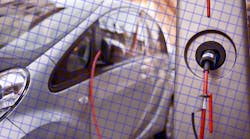Too many plug-in electric vehicles (PEVs) charging without coordination degrade the nation’s electric grid, according to research conducted by the U.S. Department of Energy’s National Renewable Energy Laboratory (NREL). The research, based on computer simulation done by Matteo Muratori, a transportation and energy systems engineer at NREL, indicates that the full benefits of vehicle electrification will necessitate a systems-level approach that treats vehicles, buildings, and the grid as an integrated network.
“Previous research into the amount of energy required by homes hasn’t taken into account plug-in electric vehicles,” says Muratori. “Given that more people are choosing to drive these types of vehicles and charging them at home, this additional demand should not be overlooked.”
NREL engineer Matteo Muratori studied how widespread PEV charging will affect the grid. (Photo by Dennis Schroeder/NREL)
The simulation concluded that a PEV market share of up to 3%, which translates to about 7.5 million vehicles, does not significantly affect aggregate residential power demand. More than 600,000 plug-in electric vehicles were already on the road at the end of 2016, a figure that includes about 150,000 sold during the year.
Muratori also looked at the effect PEV charging might have on a residential distribution transformer. In this case, a problem arises when motorists in a local geographic area began buying PEVs vehicles and plugging them in to recharge upon returning home, a practice known as uncoordinated charging. Even without large numbers of PEVs on the road, he explains, this clustering effect significantly increases peak demand seen by distribution transformers, and might require upgrades to the electricity distribution infrastructure.
The research also looked at whether the household used the less-powerful Level 1 charging or the more-powerful (and therefore faster) Level 2 charging. Muratori found that as more PEVs are added to a neighborhood, and a higher charging power is adopted, the distribution infrastructure might no longer reliably support the local electricity demand. He also notes that the higher demand could shorten the expected life of a transformer.
Earlier studies on how PEVs might affect the grid assumed utilities would have some control over when charging occurs, referred to as coordinated charging, which will greatly simplify PEV integration. Muratori acknowledges that might be true in the future, but not necessarily. Future research, he says, should focus on understanding consumer behavior to determine charging requirements, and the choice between using Level 1 and Level 2 residential charging equipment.


